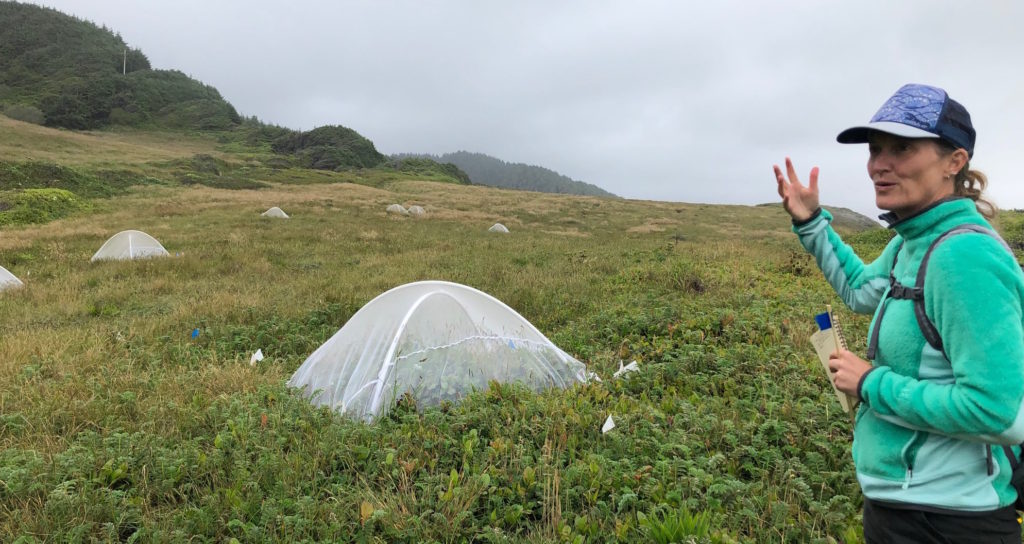
By QUINTON SMITH/YachatsNews.com
Erica Henry carefully lifts the netting from the side of the small, improvised tent and squirms underneath.
Once partly inside, she begins to poke among the grasses and tiny, wild violets in search of rare caterpillars transplanted weeks earlier from a special breeding program at the Oregon Zoo.
That caterpillar carries the hopes and efforts of state and federal agencies, the zoo and dozens of other partners to keep the Oregon silverspot butterfly from extinction.
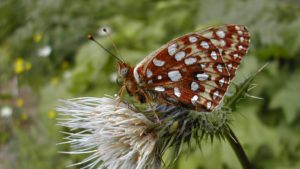
The silverspot is found naturally in two fields south of Yachats, on Mount Hebo and Cascade Head in Oregon and near Lake Earl in California’s Del Norte County.
Henry estimates 200 butterflies will emerge this summer from the grass fields at Rock Creek and Brays Point.
Researchers with the U.S. Forest Service and the U.S. Fish & Wildlife Service have been have been studying and trying to revive the declining population of the Oregon silverspot since 1980, when it was put on the federal threatened species list.
The effort has increased this year, focusing on the habitat at Rock Creek and Brays Point in an effort to determine how to best manage the coastal fields that are the only home to the butterfly.
Despite 30 years of effort, the numbers of silverspots in the wild – as far as researchers can determine – continues to decline. The question is why?
“We need to figure out why our management is not influencing the silverspot,” said Deanna Williams, head biologist for the Siuslaw National Forest. “We’re trying to turn this around with science guiding some of our management.”
And that’s why researchers are concentrating on the fields south of Yachats this summer.
“This is the first time we’ve tried to do this type of research in the wild, in their natural habitat,” said Michele Zwartjes, the field supervisor of the USF&WS office in Newport. “We are really ramping up our efforts to increase our understanding of the butterfly — and the research you’re witnessing is a part of that effort.”

Declining range
The silverspot once ranged from the Long Beach peninsula in southwest Washington to northern California. But when it was first listed as endangered in 1980 its only known location were on two “salt-spray” meadows overlooking the ocean near Rock Creek south of Yachats.

Wild populations were subsequently discovered nearby at Brays Point, and on Mount Hebo, Cascade Head and the Clatsop Plains south of the Columbia River. Over the years the butterfly disappeared from the Clatsop Plains and Long Beach peninsula.
In 2017-18 two experimental populations were established at Saddle Mountain in Clatsop County and the Nestucca Bay National Wildlife Refuge using caterpillars and butterflies from the Oregon Zoo’s breeding program.
Mount Hebo has the most robust population, measured in an “index” that indicates the numbers over time and is considered to be less than the actual population. The 2020 index had 1,423 silverspots at Mount Hebo, 190 at Rock Creek, 18 at Brays Point and just three at Cascade Head.
The Fish & Wildlife Service says the butterfly is vulnerable to extinction because of the small size and isolation the habitat-friendly sites. These open meadows were never common, the agency wrote in 2001, but created by Native American tribes, or salt-laden winds, grazing or controlled burning.
It is that habitat at Rock Creek and Brays Point that agency researchers are more intensely focusing on this year.
“It’s such a tricky place. There’s so much wind sometimes,” says Henry, a post-doctoral researcher with Washington State University who spent the last 10 years on the East Coast studying endangered butterflies.
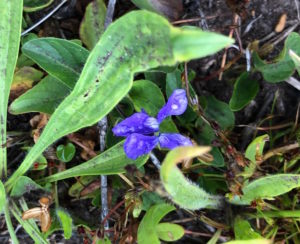
Making the Oregon silverspot population even more fragile is that its life cycle revolves around a single host plant – the early blue violet. The small plant is the only flower on which the butterfly larvae can successfully feed and develop.
After learning how to successfully augment the butterfly population with the zoo’s hatchery program, more attention is now focused on habitat improvement – including transplanting patches of violets, mowing and cutting back or removing invasive grasses.
“If you change the structure of the meadow, does that alter survival?” Henry asks. “That’s what we’re trying to determine.”
Why save it?
While the U.S. Fish & Wildlife Service is the lead agency to keep the silverspot from extinction, it has help – up to 30 different agencies or groups. The U.S. Forest Service, Oregon State Parks and Recreation, the Oregon Zoo in Portland and Woodland Park Zoo in Seattle, the Nature Conservancy and local soil and water conservation districts are all involved.
In addition to Henry and field technicians, the Newport office has a lead biologist focused on the silverspot and is now sharing a habitat restoration specialist with the Forest Service.
The USF&WS’s regional office in Portland was unable to provide an estimate of the yearly cost of the conservation effort, but the agency’s 2001 conservation plan estimated the effort from 2001 to 2019 would cost $14 million.
“This is what the Endangered Species Act is meant to do … it’s not something that we decided was important, but that the American public has said through their support of the act,” said Zwartjes. “And it’s not just the Oregon silverspot butterfly … we’re losing the coastal, native grasslands. The effort to help the silverspot also helps other species.”
Using ‘detection’ dogs
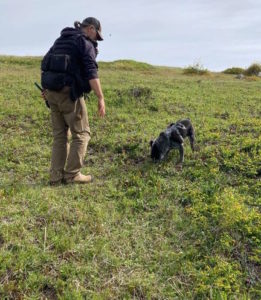
The story of the Oregon silverspot is unusual. This is where it gets even more so.
From 1980 to 2020 there was only one – yes, one – silverspot caterpillar detected in the wild by a human. Yet, researchers could see and count butterflies when they emerged in the summer.
Williams was using a specialty dog service based in eastern Washington to search for droppings of the rare Pacific Marten when she asked if they could train the dogs to detect caterpillar poop – called “frass.” The answer was yes.
A trained rescue dog from Rogue Detection Teams first worked the Rock Creek fields in 2015, but because it was a severe drought year the dog was “indicating” caterpillars in unusual areas, Williams said. While researchers could not spot the actual caterpillars, she said, they were able to find signs they had been feeding on blue violets.
This year, a detection dog returned to Rock Creek in late May, helping Williams and other researchers confirm 13 caterpillars over four days.
“Remember, there had been just one caterpillar found in the wild since 1980,” Williams said. “This helps us determine what kind of habitat in which they are successful.”
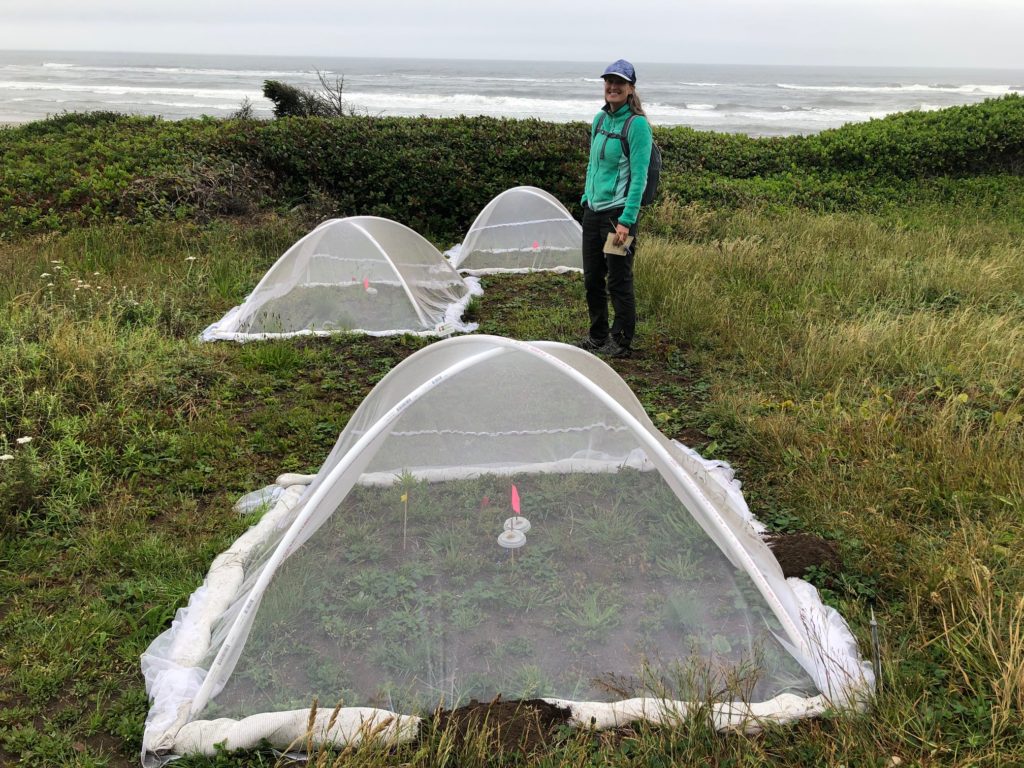
Life stages
The butterfly emerges from the caterpillar’s chrysalis in late summer and begins feeding on nearby flowering plants. In a few weeks the silverspot lays 200 or so eggs the size of sesame seeds near the blue violets. The eggs hatch in about 16 days and tiny larvae travel a short distance to find a suitable spot where they hibernate and try to survive the winter.
If they survive, the larvae awake in the early spring and begin to feed. As they grow they go through five molts – shedding their outer covering – before they enter their adult stage and form the chrysalis. About two weeks later the silverspot emerges, begins feeding on flower nectar, possibly find a mate and begin the process all over.
“They’re always here,” Henry says. “Their whole lifecycle is in these meadows.”
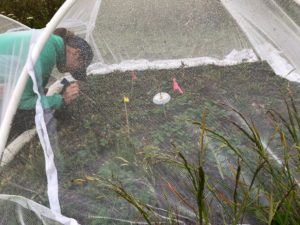
Henry’s job this summer is to collect data from the fields at Rock Creek and on Brays Point.
In one field, the Siuslaw National Forest cleared grasses and planted dozens of blue violets. In the adjacent field, patches of grass were mowed during the fall.
Several weeks ago Henry erected tents that she designed – PVC pipes in an X-shape that form a half-dome four feet wide on each side. She sewed the netting herself, and then used 3-inch medical bandages filled with sand to anchor the sides.
That’s what motorists on nearby U.S. Highway 101 are seeing to the west as they travel between Yachats and Florence.
Sixteen of the tents are at Rock Creek, six in the new violet patches and 10 in the meadows. Ten more are on the steep hillside of Brays Point’s, high above the highway.
“It’s the first year we’ve used the dome tents,” Henry says, and therefore “There’s a lot of troubleshooting involved.”
Butterfly hatchery program
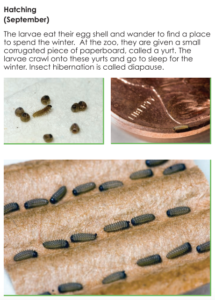
The Oregon Zoo has been raising Oregon silverspots for 20 years – think fish hatchery except with butterflies – and each spring delivers 1-inch caterpillars and in late July hundreds of butterflies to the coastal meadows and hopes for the best.
But this year, seven caterpillars were released inside each of Henry’s tents so their development can be tracked – do they do best in the field of transplanted violets or in the mix of grasses and violets, or in areas where grasses have been trimmed?
“Things in the wild operate quite differently,” Henry says, based on temperature, wind, and available plants. “They have to work a little harder.”
Last week the first “wild” butterflies emerged from the grasses, Henry said, but there are none yet from the zoo-raised caterpillars inside the tents.
“We saw butterflies flying, so we know there’s wild butterflies out there now,” she said.
Once more butterflies emerge in late July and August, Henry and two technicians will be in the two fields seven days a week counting and marking – yes, with a fine-point Sharpie – wild and zoo-raised butterflies to study their movement. They will also capture some to send to the zoo for the breeding program.
The fields at Rock Creek and Brays Point are the only ones where research is taking place this summer.
“We wanted to start small,” Henry says. “There’s hope that if this works we can expand it across the range.”

And what is learned at Rock Creek and Brays Point is designed to provide science to help the Forest Service manage thousands of acres of coastal lands it oversees.
“It’s a systems thing,” said Williams. “The silverspot has been telling us that the coastal systems are struggling. We have to understand all the pieces so we can help save the larger system.”
Williams said the detection of caterpillars this spring and wild butterflies spotted already this summer is a good sign.
“We’re discovering there is enough food out there for caterpillars,” she said. “It’s giving us hope that we haven’t lost Rock Creek yet … we just have to be more targeted in how we manage.”




The Yachats prairie is Silver spot habitat as well, the violet grows abundantly here…..